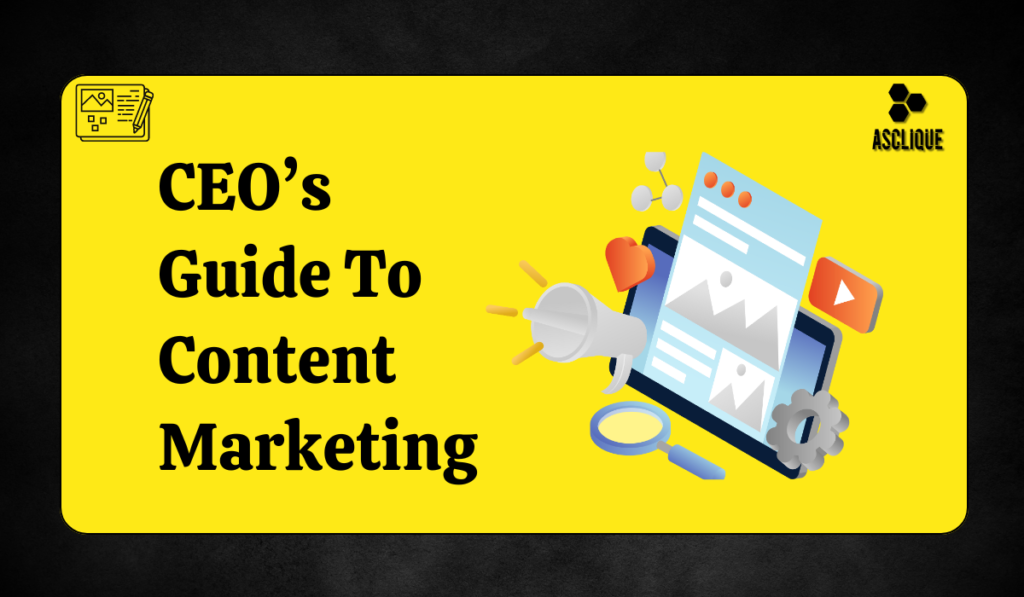Content marketing has become a vital component of corporate growth in the increasingly digital marketplace. It aids in the development of brands, audience engagement, and lead generation. However, many CEOs view content marketing as an abstract concept suited for the marketing division. In reality, it is a vital strategy that can drive overall business success. A ceos guide to content marketing can differentiate between a successful, revenue-generating strategy and one that fails. This article will discuss how aligning content efforts with sales goals can boost company growth.
Understanding the Strategic Value of Content Marketing
First Step to Understanding the Real Value of Content Marketing for Business Growth for Any CEO: What is content marketing? It isn’t merely a matter of blogging or making the popular video trend-it’s about adding value at every stage of the customer journey.

Content can really help in many areas, including the following:
- Increasing Brand Awareness: Your brand will be able to naturally reach a larger audience by providing insightful and valuable content.
- Create Qualified Leads: A reader who is curious in your content can become a qualified lead by downloading an eBook, watching a case study, or attending a webinar.
- Customer Loyalty: Educational or informative content keeps your audience engaging and coming back for more, thus driving customer retention.
As a CEO, you will consider content marketing as an investment that supports various stages of the sales funnel from awareness to retention.
Alignment of Content with Business Goals
- Establish Measurable Goals: Establishing measurable goals is the first stage in coordinating content with the business’s goals. To grow revenue by 15%, your content should be focus on lead generation, lead nurturing, and driving conversions with case studies and testimonials.
- Customize Content for Each Buyer Stage :CEOs should support a content strategy that spans the buyer journey, with top-of-funnel content (blogs, social media) raising awareness and middle-of-funnel content (case studies, whitepapers) attracting customers. Conversions will be fueled by bottom-of-funnel content (customer stories, product demos).
- Engage the Sales and Marketing Teams: Ensuring content addresses key sales challenges is a great way for CEOs to foster collaboration between sales and marketing teams. Your content will be more effective at pushing leads down the funnel if it is more sales-aligned.
Invest Into Quality, Not Quantity
Quality content ultimately matters more than quantity, even though the urge to fill the internet may be tempting. Thus, CEOs should prioritize “quality over quantity,” ensuring content is well-crafted and targeted at the right audience.
- Support Deep-Dive Content: High-value content, like in-depth guides and industry reports, boosts engagement and establishes thought leadership. Thus, CEOs should promote fewer but more impactful pieces that provide real value to content marketers.
- Create an Authority Brand. This is one of the best ways to build trust and authority in the market. You should encourage your marketing team to be able to create content that informs but also conveys your message that your company is an expert in the field. As a CEO, you can contribute by publishing op-eds, doing podcasts, or writing your own insights.
Nurture a Cross-Functional Content Culture
It cannot live in isolation within the marketing department. Some of the best content ideas come from outside the marketing department or even from product development, customer service, or sales teams. It’s up to the CEOs to build this cross-functional content culture and invite contributions throughout the business.
- Promote Interdepartmental Cooperation: CEOs ought to provide their staff with chances to work together on content initiatives. For instance, product development can offer specialized knowledge for technical content, while customer service can offer insights into typical customer problem points.
- Leverage Employee Advocacy: Some of your finest content promoters may be your employees. Chief executive officers might encourage teams to share their knowledge, write articles, or update company blogs in order to support employee-generated content.
Maximizing ROI for Content Marketing
For most CEOs, ROI will be the toughest problem they will ever face-the return on investment when using content marketing strategies. Among the bright spots in content marketing is that, if done right, it will be one of the cheapest methods to grow a business over time.

Personal Involvement in Thought Leadership
The face of a company is often its most important marketing tool—the voice of the CEO. Moreover, thought leadership through personal involvement in content marketing enhances brand credibility and attracts customers and industry partners.
- Publish CEO-Led Articles: As an industry expert, you create credibility by offering your personal perspectives and experiences on leadership, market trends, and company obstacles. You can provide your audience with direct access to your vision by writing for trade journals or your company blog.
- Interview and Podcast: Many CEOs have been successful by participating in industry podcasts, webinars, and speaking events. This is an excellent way to leverage your subject matter expertise while collegially promoting your brand.
- Advocate Newness and Trends: Discuss emerging trends or be a voice for an industry disruption as a CEO. This puts your company on the cutting edge of the market while driving engagement with meaningful, forward-thinking content.
Building a Sustainable Content Strategy
One of the primary tasks of a CEO is to see that content marketing works sustainably at scale. Sustained success requires integrating content into the business plan for growth and allocating resources accordingly.
- Involve the Correct People and Resources: Skill is necessary for scalable content marketing operations. CEOs should ensure their teams are adept in content development, strategy, and measurement tools.
- Long-term-focused growth strategy: content marketing is a marathon, not a sprint. CEOs must set realistic expectations early on and give their staff enough tools to produce high-quality content over lengthy periods of time if they want to see results.
- Optimize and Adapt: As the digital environment changes constantly, so too should the content strategy. CEOs must make sure that the activities of their teams are continuously optimized in light of performed data and market trends.
Conclusion
One of the finest techniques for CEOs to achieve business growth is through strategic monitoring and connecting content marketing with business goals. CEOs can drive long-term success by valuing content marketing, investing in quality, fostering teamwork, and tracking revenue impact. For CEOs, it’s about inspiring the team to create content that aligns with their vision and drives business value; rather, it’s not about micromanaging posts. Effective use of content can create market leadership and open up opportunities for growth.
FAQ’s
What is Content Marketing?
Content marketing is a strategic approach focused on creating and distributing valuable, relevant content to attract and engage a target audience, ultimately driving profitable customer action.
What is the Difference Between Content Strategy and Content Marketing?
Content strategy involves planning, developing, and managing content to achieve specific business goals; in contrast, content marketing focuses on using that content to attract and retain customers. Thus, both are essential for business success.
How Can I Use Content Marketing for My Business?
You can use content marketing by creating informative blog posts, engaging social media content, videos, and other formats that resonate with your audience and align with your business objectives.
Can I Craft an Effective Content Marketing Strategy?
Yes, you can craft an effective content marketing strategy by defining your goals, understanding your audience, creating valuable content, distributing it through appropriate channels, and measuring its impact.

